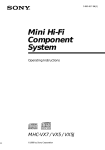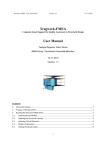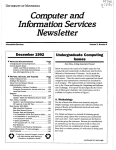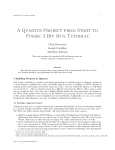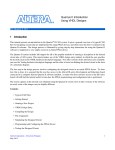Download An Assessment of Current Qualitative Simulation Techniques
Transcript
An Assessment of Current Qualitative Simulation Techniquest Pierre Foucbe & Benjamin Kuipers Department of Computer Sciences The University of Texas at Austin, Austin TX 78712, USA Email: fouche@cs .utexas .edu, kuipers@cs .utexas .edu Abstract : QSIM is a powerful Qualitative Simulation algorithm, which now includes many features that have proven to be necessary in Qualitative Simulation. These features are: reasoning with Higher-Order Derivatives, having Multiple Levels of Abstraction, reasoning in the Phase Space representation, and reasoning about Energy. The aim of this paper is to provide a comprehensive view of all these techniques, by explaining their rationale, showing the problems they address and how they interact. Remaining problems in Qualitative Simulation are also discussed. Main Topic: Qualitative Simulation t This work has taken place in the Qualitative Reasoning Group at University of Texas at Austin. Research of the Qualitative Reasoning IRI-8602665, IRI-8905494, and IRI-8904454, by NASA grants NAG Advanced Research Program under grant no . 003658175. Pierre Fouch6 the Artificial Intelligence Laboratory, The Group is supported in part by NSF grants 2-507 and NAG 9-200, and by the Texas holds a grant from Rh6ne-Poulenc. Fouehd & Kuipers - An Assessment ofCurrent Qualitative Simulation Techniques Introduction Qualitative Physics has experienced a rapid growth since its birth, generally dated to the special issue of the Artificial Intelligence Journal of December 1984 . Among all the formalisms that have been developed, QSIMI . originally designed by Kuipers [86] has been greatly improved by many researchers since. It now includes several features that have proven to be necessary in Qualitative Simulation, like reasoning with higher-order derivatives [de Kleer & Bobrow, 84 ; Kuipers & Chiu , 87], having multiple levels of description [Hobbs, 85 ; Kuipers & Chiu , 87], reasoning in the phase space representation [Sacks, 87; Struss, 88 ; Lee & Kuipers, 88; Doyle & Sacks, 89] and reasoning about energy [Fouch6 & Kuipers, 90a, 90b] . So far these techniques have been described separately and have not been compared to each other. Consequently it was not easy to decide, even for someone very familiar with Qualitative Simulation, which one to apply to solve a practical problem. This paper is an attempt to provide a comprehensive view of these techniques : for each of them we describe their rationale and intuitive appeal, and we compare their relative efficiency on two simple examples, widely used in the Qualitative Physics literature2: a block-spring system with or without friction . The fast part of the paper presents the models and the result of their simulation with the QSIM kernel. It is shown that simulation is intractable, mainly because of a phenomenon known as Chatter. The second part is devoted to local reasoning techniques . Section 2.1 shows that reasoning with higher-order derivatives and introducing curvature constraints allows to eliminate this phenomenon, but that the real problem for the damped spring is that the level of description is not appropriate : the system is not constrained enough for QSIM to predict a total ordering of the relative occurrence of events, and behaviors keep proliferating . This phenomenon is referred to as Occurrence Branching . An alternate way to get rid of chattering, which turned out to solve in part the occurrence branching problem is to shift to a higher level of description by ignoring irrelevant distinctions . This is described in section 2 .2. All the preceding techniques still do not provide a good behavioral description of the damped-spring : QSIM still derives behaviors which are genuinely incompatible with any actual system that abstracts to the model. This problem of incompleteness mainly stems from a combination of the loss of quantitative precision with the local character of qualitative inferences . A way to get a global view of a system behavior is to use the Phase Space representation, as described in section 3.1 . This allows QSIM to derive that some properties of a system cannot change through time. The final step to get a correct behavioral description of the spring system is to introduce energy considerations, as shown in section 3.2. A summary is provided in section 4. With the help of all these techniques, QSIM is now able to derive important properties of industrially significant systems [Fouch6 & Kuipers, 90a, 90b]. However some problems still remain : The way QSIM handle correspondences between qualitative values and creates new landmarks is not satisfactory ; QSIM provides no result about asymptotic behaviors ; Finally QSIM cannot always determine whether a behavioral property is a system property. This is described in section 4. 1 . Basic Qualitative Simulation The Spring-Block system (figure 1 .1) consists of a block connected to a spring laying on a horizontal table. The block position is referenced by a variable X, the origin being the rest position. The frictionless system will often be referred to as the simple spring, and the other as the damped spring . Though extremely simple from a structural point of view, deriving their behaviors qualitatively has turned out to be challenging . We know that the IFor a detailed description of QSIM, see [Kuipers, 861; see [Kuipers, 89] for a tutorial view . 2For instance : [de Kleer & Brown, 84 ; FOrbus, 84 ; Kuipers, 86 ; Weld, 87 ; Trav6 & Dormoy, 88 ; Struss, 88 ; Lee & Kuipers, 88 ; Ishida, 89] Fouehes & Kuipers - An Assessment of Current Qualitative Simulation Techniques 2 40 Figure 1 .1 : The Spring-Block System force FS exerted by the spring on the block is inversely proportional to its elongation X. While the relation between FS and X happens to be linear (Hook's law), we shall not make any linearity assumption, to demonstrate that Qualitative Simulation applies to non-linear systems . For the simple spring, we can directly model that the acceleration is inversely related to the position of the block. For the damped spring, the friction force FF is inversely proportional to the speed of the block and again we shall not assume that this relation is linear. Figure 1 .2 shows the models as they are given to QSIMI . (define-QDE simple-spring (quantity-spaces (X (minf 0 inf)) (V (minf 0 inf)) (A (minf 0 inf))) (constraints ((d/dt X V)) ((d/dt V A)) ((M- X A) (minf inf) (0 0) (inf minf)))) (define-QDE damped-spring (quantity-spaces (X (minf 0 inf)) (V (minf 0 inf)) (A (minf 0 inf)) (FF (minf 0 inf)) (FS (minf 0 inf))) (constraints ((d/dt X V)) ((d/dt V A)) ((M- FS X) (minf inf) (0 0) ((M- FF V) (minf inf) (0 0) ((add FS FF A)))) (inf minf)) (inf minf)) Figure 1 .2 : QSIM models of the simple and damped springs Simulation with the QSIM kernel: what we expect. .. We start the simulation with the spring stretched and the block immobile . The beginning of the expected behavior is the block moving towards its rest position. What it will do next depends on the friction force. If the motion is frictionless then the block will move across its rest position, reach another extreme and move back to its original position. One can describe this behavior as a stable oscillatory behavior . If friction occurs then it can move towards the rest position without crossing it, if the friction force is strong enough. This is an over-damped behavior. Otherwise, the system will exhibit decreasing oscillations. ... and what we really get Figure 1 .3 shows the behavior tree2 of the simple and damped springs when behaviors are allowed to reach time point t8 and ra. Clearly this is not as simple as expected . I [Farquhar & Kuipers, 90; Throop et al., 90] describe in detail how to use the QSIM is implementation. 2 A filled circle represents a state at some time point, an empty circle a state at some time interval, a filled circle surrounded by a larger circle a quiescent state and an empty circle surrounded by a larger one a cyclic state, identical to a prior state in the same behavior. States followed by dashed lines are states whose successors have not been computed yet, due to a resource cut-off. Time increases from left to right. t, ;.r Fouchd & Kuipers - a 3 An Assessment of Current Qualitative Simulation Techniques LM Figure 1 .3 : Behavior trees produced by the QSIM kernel (a) simple spring, time limit tg, 26 behaviors (b) damped spring, time limit tq, 56 behaviors Problems with the damped spring Figure 1 .4 shows a particular behavior of the damped spring. Analyzing the distinctions among all the behaviors reveals that only the acceleration has distinct behaviors. The explanation is that the acceleration is constrained only by continuity: it is the sum of a continuously increasing function (the friction force) and a continuously decreasing function (the spring force) . Since we have no more information about these two functions, their sum can be a decreasing, steady or increasing function of time. While all these behaviors are real behaviors, they only occur if the functions relating speed and friction force and position and spring force have uncommon shapes . If one can make additional assumptions about their second derivatives, which are valid for actual spring systems, these behaviors are no longer possible . This is developed in section 2.1 . ". . . . .+ . ....1. ....+.....+.... .1.... .1... ..1 ... ..1 H ladiiao 71 H n T~ Vd/elq AmeYW+lir Figure 1 .4: One chattering behavior of the damped spring t!J!j An Fouch6 & Kuipers Assessment of Current Qualitative Simulation Techniques 4 Problems with the simple spring The first tree of figure 1 .3 starts branching at time t4 . Figure 1 .5 displays the three possible behaviors computed until that time. In behavior (a), the block stops before its initial position. In behavior (b), the block goes beyond and in behavior (c) the system comes back to its initial state. Of course only the last behavior is genuine [Kuipers, 86] . In fact solving the problem requires a global point of view on the system behavior. -m -m PosMbn 71 PosMbn r1 rr n r. Posltgn Figure 1 .5 : Three way branching of the simple spring 2 . Local Reasoning Techniques 2 .1 . Reasoning with Higher-Order Derivatives The phenomenon that occurs for the damped spring is a particular instance of a more general problem, called Chatter. de Kleer & Bobrow [84] and Kuipers & Chiu [87] proposed solutions. The state of the art is presented in [Kuipers et al., 89] . Principle Roughly speaking, a variable may exhibit chatter if its derivative is unconstrained . Chatter doesn't occur for the simple spring because the acceleration has a behavior similar to the position whose derivative is explicitly represented . Basically, if at sometime point a variable transitions to a critical point (that is, its derivative becomes zero) then its qualitative value in the next open interval of time is determined by its second derivative. If no information is provided about this second derivative then QSIIVI will branch on each possible future . Multiple occurrence of this phenomenon leads to intractable branching. The method proposed in [Kuipers et al., 89] is performed in three steps: Identify equivalence classes of variables in the QDE likely to chatter; Derive an expression (called the curvature constraint) for the second derivative of one variable among each classt; Use the sign of the second derivative to constrain simulation 2 . 1 Derivation can be performed manually or automatically by an integrated algebraic manipulator. 2 Curvature constraints provide useful information only when they are not ambiguous, that is when the sign of the second derivative is positive or negative. When it is zero, then the same problem occurs and the next qualitative value of a chattering variable is given by the sign of its third derivative. For the damped spring 100 Kuipers Fouchd & An Assessment ofCurrent Qualitative Simulation Techniques Figure 2 .1 : Tree 5 of behaviors of the damped spring using curvature constraints Deriving curvature constraints in the presence of monotonic (M+ or M-) constraints requires additional assumptions about them : the semantics of M+(Y, X) is that there exists a function f such that b' t, Y(t) = ,f(X (t)) with f (x) > 0 . This implies that dY = r7X 1 but d2X and d2Y are not related. The assumption that d2X = d2 Y is called the sign-equality assumption and is applied by the algebraic manipulator. This assumption is obviously satisfied when fis linear but more generally when fs shape is relatively smooth2. Results Figure 2.1 shows the tree of behaviors for the spring with friction when simulation is allowed to reach time point t7. Instead of 56 behaviors at time t4, only 4 are produced . But the tree is still growing exponentially. Figure 2.2 shows the three possible behaviors at time t2. Time t2 is defined either by X crossing zero, A reaching a critical value, or both at the same time. In the linear case, the relative occurrence of these events is a system property [Lee et al., 87], that is, a property that depends on the parameters of the system, but that that does not vary during simulation . In the general case, it depends on the functions FF and FS and thus any order on the occurrence of events is possible . The point is that even if these distinctions are real we do curvature constraints are always not ambiguous. See [Kuipers et al ., 89] for a complete discussion of the use of Higher-Order Derivatives in Qualitative Simulation . ldX is a notation used by de Kleer & Bobrow [84] and represents the sign of X's derivative. By extension, a"X represents the sign of X's nth derivative and dOX the sign of X. 2See [Kuipers et al., 89] for a discussion of physical situations in which these assumptions may be violated . 2ol 6 Fouchd & Kuipers - An Assessment ofCurrent Qualitative Simulation Techniques ar 017 .i . . . . .+ . . . . .+ UM r" Position n » Position Position - ar " Zn - or " t " rxv - rxn T" Velocity Velocity t TI » VNOCQY - xrr - ar . . - 4r - rxv Aooallerabon 71 (a) » mr Aooelleraoon Acwllaration (b) Figure 2 .2 : Three way branch at time t2 (c) not care about them. When we describe the behavior of a spring informally, we are interested in the position of the block, its speed, and also whether it is accelerating or decelerating . In other words we are just interested in the sign of the acceleration but not its derivative: the level of description is not appropriate and we are getting lost in too detailed a behavioral description. 2 .2 . Switching to a Higher Level of Description Ignoring irrelevant distinctions In the preceding section, simulation was branching according to the ordering of the following events: A reaches a critical value and X crosses zero. The former event is not of particular interest and Kuipers & Chiu [87] developed a method to ignore this irrelevant distinction: If the directions of change inc, dec and std are collapsed into a single value ign then branching will no longer occur since it is impossible to detect critical values. Ignoring directions of change has three main advantages over using information about higher order derivatives " No assumption is made about the nature of M+ or M- instances and thus soundness is preserved . " No algebraic manipulation has to be made to derive higher-order derivative properties . " It eliminates occurrence branching caused by a variable reaching a critical value . However, in some cases : " Information about higher-order derivatives is required to filter out genuinely spurious behaviors [Dalle Molle, 89; Kuipers et al., 89], that the ignore-gdirsl method does not rule out. Higher-order derivative constraints usually perform better than ignore-gdirs on non-oscillatory systems. " It may be very interesting to know explicitly the direction of change of some variable. 1 Short for Ignoring the qualitative direction of change Z- o Z 7 Fouch6 & Kuipers - An Assessment ofCurrent Qualitative Simulation Techniques Results Figure 2.3 shows the tree of behavior of the damped spring using the ignore-gdirs method for the acceleration . Instead of 60 behaviors at time t7, only 7 behaviors are produced at the same time and 50 if simulation is allowed to run until time too, but we still have too many behaviors... ~-o Figure 2.3 : Tree of behaviors of the damped spring, ignoring the direction of change of the acceleration Browsing the tree reveals that many of them are intuitively spurious and figure 2.4 shows one of them: the block seems to oscillate with increasing amplitude when X is positive and constant amplitudes when X is negative . But reasoning about oscillations requires a global point of view. r 7 7, 73 Position 7t n 7, Sf 76 11 4 T 71 R . 7, 71 T T 7, T N T T T R 1 r 71, Velocity Amttentioo Figure 2.4 : An intuitively spurious behavior 3 . From a Local to a Global Point of View The filtering techniques we have discussed so far have been purely local: Determining the validity of state transitions has been made by considering only two successive states, and the basic validity criterion has been continuity of variables. But the first thing that we are thinking of when we are looking at a spring is oscillation. And dealing with oscillation requires a global view of a system behavior : it involves comparing the state of a system at 2o3 Fouch6 & Kuipers - An Assessment of Current Qualitative Simulation Techniques 8 a given time with its state at some time before, and these two time points are not successive in our qualitative description. For instance, expressing that "the amplitude of oscillations starts increasing" in figure 2.4 requires comparing the qualitative magnitude of the block position at time points t7 and to. One way to reason globally about a system is to use a phase space representation . 3 .1 . Changing of Representation : the Phase-Plane View The Phase Space for a system is the Cartesian product of a set of independent variables that fully describe the system . In practice, it provides another view of system behavior : a point in the phase space represents a system state and a trajectory a behavior. Principle of the Non-Intersection Constraint A major theorem about the existence and uniqueness of the solution of an autonomous first-order ordinary differential equation system has a direct equivalent in the phase space representation: A trajectory which passes through at least one point that is not a critical point cannot cross itself unless it is a closed curve. In this case the trajectory corresponds to a periodic solution of the system . Lee & Kuipers [88] and Struss [88] discovered that this property can be conveniently translated into qualitative terms for second order systems. In this case, the phase space is a plane and a general intersection criterion can be established even if trajectories are described qualitatively. This criterion can then be used to rule out trajectories that intersect themselves . Figure 3.1 shows the Non-Intersection Constraint at works : the behavior corresponds to figure 2.4 . In the phase plane (V A) the trajectory is a closed curve and thus the behavior should be cyclic and trajectories in other phase planes be closed curves too. But this is not the case and the behavior is labeled as spurious (x at the end of each trajectory) . F r la . _ W1 z f .Snf XvaA a-1 0 a-0 a-I 1nf .Snf VvsA v-0 0 wl inf .Snf a-1 0 a-0 a-7 inf XWXV Figure 3.1 : The Non-intersection Constraint at work Results Figure 3.2 shows the relative efficiency of the Non-Intersection Constraint on the damped spring example. Instead of 50 behaviors only 15 are created at time t1o. Note that only one cyclic behavior is now detected. One can see that the tree is divided into three main branches at time t6. The upper branch corresponds to increasing oscillations, the middle to damped oscillations and the lower to stable oscillations . It is interesting to compare this tree with the one obtained for the simple spring using the Non-Intersection Constraint (figure 3.3). The two trees are very similar. For the simple spring branching 1 One must notice that in the quantitative case, only one among all possible couples of independent variables is necessary to check the non-intersection property . However, since reasoning qualitatively implies losing a certain amount of information, all possible phase planes must be taken into account to fully capture the Non-Intersection Constraint: one phase plane may contain information that is not present in another one. 2 oy Fouch¬ & Kuipers - An Assessment of Current Qualitative Simulation Techniques 9 Figure 3.2 : Tree of behaviors for the damped spring with NIC until time t,o occurs at time t4 instead of time t6 and the branch corresponding to decreasing oscillations is placed at the top of the tree instead of at the middle. Figure 3 .3: Tree of behaviors for the simple spring with NIC until time tjo Let us analyze more deeply the differences: " Qsim does not allow the simple spring to reach quiescence . " The reason for the time difference between the first branching occurrences (t4 for the simple spring and t6 for the damped spring) is that the variables X and A are in phase for the simple spring but there is a phase difference for the damped spring . This phase difference implies the creation of distinct time points for the events A crosses 0 and X crosses 0. " Both trees exhibit more branching on the branch corresponding to increasing oscillations . The explanation is given in section 5. But of course only damped oscillations are valid for the damped spring and only stable oscillations for the simple spring . Determining unambiguously the character of oscillations (damped or stable) requires energy considerations . 3 .2 . Reasoning about Energy Intuitively increasing and decreasing oscillations for the simple spring (figure 1 .5 .a and b) are spurious because the system is conservative (the mechanical energy is conserved) 2OS 10 Fouchd & Kuipers - An Assessment of Current Qualitative Simulation Techniques and the potential energy of the block depends only on its position . Fouch6 & Kuipers [90a, 90b] developed a method, implemented as a global filter called the Energy Constraint, that automates this reasoning. It is based on a qualitative interpretation ofthe Law of Conservation of Energy, and on the decomposition ofprocesses into conservative and non-conservative onesl . It consists of computing the sign of the work of conservative and non-conservative forces and checking that this is compatible with the sign of the variation of kinetic energy . The Energy Constraint, like the Non Intersection Constraint, takes advantage of two main features of QSIM : it creates new landmarks during simulation, thus providing enough information to compute the sign of the quantity defined above, and it describes behaviors of a system directly in terms of its variable histories, which makes non-local reasoning very natural. Results Currently, QSIM has to be provided with the name of variables representing conservative and non-conservative terms, C and N, For both the simple and the damped springs, the decomposition of the acceleration is trivial: " For the simple spring : C(X(t)) = A(t) and N,(t) = 0. " For the damped spring : C(X(t)) = Fs(t) and N,(t) = FF(t). With the Energy Constraint, QSIM is able to determine that the two first behaviors of figure 1 .5 are spurious with the following justifications : " a: Inconsistent : between t0 and t9, Ke-var - 0, C-work - +, NC-work - 0 " b: Inconsistent : between t0 and t4, Ke-var - +, C-work - 0, NC-work - 0 and thus we come up with only one, genuine behavior for the simple spring. Applying the Energy Constraint to the damped spring also allows to get the correct behavioral description as shown in figures 3.4 and 3.5 . We come up with one infinite, pseudo-cyclic behavior, exhibiting decreasing oscillations, and an infinite set of quiescent behaviors, for the system can become over-damped each time the block is moving toward its rest position . If the system was linear, it could not become over-damped after the first oscillation, but without a linearity assumption, these are genuine behaviors. Figure 3.4 : Tree of behaviors of the damped spring r r 6. 411 ; PURIM it Vdeolq » i» is » » » »r iii n~ rr o i~ » » io ru nl rr Aeedlelir Figure 3.5 : Decreasing oscillations of the damped spring 4 . Summary Here are two tables that summarize the results of applying these different techniques to the simple and damped springs . Figures in bold type-face indicate that the number of behavior is correct. 1 This method is actually not restricted to mechanical systems and is applicable to any second- or higher-order system . 2- 0 6 Fouch6 & Kuipers - An Assessment ofCurrent Qualitative Simulation Techniques Simple Spring QSIM Kernel Non-Intersection Constraint Energy Constraint i Damped Spring QSIM Kernel Higher-Order Derivatives Ignore Qdir Ignore Qdir and Non-Intersection Constraint Ignore Qdir and Energy Constraint 4 3 3 1 4 56 4 2 2 2 t8 26 7 t7 Too man 60 7 5 3 tl o Too man Too man 50 15 4 5 . Open Problems Apparently we are now able to correctly simulate any reasonably complex system without any problem. Of course this is not true and some problems still remain . Constraint Checking VS Limit Analysis Currently QSIM uses landmarks to both check constraints (by the means of corresponding values) and perform limit analysis. Here are two examples to illustrate that this can cause problems sometimes . Suppose for some reason we have to know the direction of change of the acceleration for the damped spring. Simulating it taking into account higher-order derivatives and applying energy filtering produces 103 behaviors at time tlo, many of them being spurious. Figure 5.1 shows one of them where the variables FF, FS and A only are plotted . SPriK term PI.N fricU- AmU~U.. Figure 5.1 : One spurious behavior of the damped spring In this behavior, the acceleration A is greater at time tlo than at time t3 . But between t3 and tlo, FS has decreased and FF(t3) = FF(tlo) : the add constraint fails to recognize an inconsistency . Because at time t3 A's qmag is a not a landmark but an interval no corresponding values were created, that would have allowed to detect the inconsistency . One way to deal with this is to propagate landmarks across constraints, allowing corresponding values to be created and consequently spurious behaviors to be eliminated. However, these landmarks will be inserted into quantity spaces and QSIM will then take them into account to perform limit analysis. As they do not represent real qualitative distinctions, this will lead to intractable occurrence branching . One could also allow correspondences between intervals . This would solve the above problem, but may fail in other cases if an interval is refined later in the simulationl . The appropriate solution is to distinguish the two tasks constraint checking and limit analysis : landmarks necessary to check constraints do not always have to appear in a quantity space. As a second example, consider a spring for which energy is provided instead of being dissipated. Simulation of such a system produces a tree similar to figure 4.2, except that 1 For instance, consider the following episode: gval(A, to)= <(Al A2), inc>, gval(A, (coal)) = <(AI A2), inc>, gval(A, tl )_ <A3 , std> with A3 e (Al A2) At ti, we know that gmag(A, to)= (Al A3) 207 FoucM & Kuipers - An Assessment of Current Qualitative Simulation Techniques 12 branches corresponding to steady or decreasing oscillations are pruned. The tree exhibits a three way pattern of branching: at each oscillation, once QSIM has determined that the block goes further away than the previous maximal position Xn, then, when the block comes back, the ordering of events X crosses Xn and A crosses zero is undetermined, leading to occurrence branching. But after Xn is crossed a first time, Xn is not of particular interest any longer and it should be withdrawn from the quantity space. We are currently experimenting with new, more flexible methods to manage creation and withdrawal of landmarks. Asymptotic behaviors: what are they ? Another issue is to determine the asymptotic behavior of oscillatory systems. Let us see on the damped spring example how this can be formulated . Let Xln be the maximal value of the position when X is positive in the nth cycle. Intuitively we can say that the oscillations tend to a limit if the sequence (Xln) has a limit when n tends to infinity . From the simulation we know that Xln is a decreasing sequence and that zero is a lower bound. Thus Xln has a limit. Let XI be this limit. Suppose we choose Xlo equal to X1. From the definition of a limit we must have Xln = Xl for all n. The only value XIo for which Xln is constant is zero and thus Xl = 0. We plan to generalize and incorporate this kind of reasoning into QSIM . Asymptotic behaviors : can they be reached in finite time ? Determining whether this limit can be reached in finite time can be done using the phaseplane representation . So far the non-intersection constraint has been used to check that a trajectory does not intersect itself, but it also prohibits intersection of any two trajectories in the same phase portrait, if they correspond to different initial conditions . Since we know that the asymptotic behavior of the damped spring corresponds to immobility at the rest position, which is itself a possible trajectory (actually a point), we can conclude that the asymptot can never be reached in finite time . Doyle and Sacks [88, 89] developed a general methodology to interpret trajectories in the phase space representation and certainly some of their techniques could be used in the QSIM framework. Is a behavioral property a system property ? Currently QSIM is not able to determine that some behavioral properties of a system do not change through time . For instance if the damped spring is linear then it cannot become over-damped after the first oscillation . We have to extend QSIM so that it can automatically determine whether a behavioral property is a system property. But at the moment these words are written, we do not know how... Conclusion We have seen that with the help of several filtering techniques (using Curvature Constraints, Ignoring the Direction of Change of a variable, using the Non-Intersection or the Energy Constraint), QSIM is now able to simulate systems that were previously intractable. We hope this paper will help QSIM users choose the appropriate methods to simulate their models. However, another possible improvement and direction of research is to automate the process of choosing these methods. Acknowledgments Pierre Fouche is particularly indebted to his advisor Jean-Paul Barthes, from the University of Compiegne, France, for his constant support and useful advice . This paper benefited from discussions with many members of the Qualitative Reasoning Group at the University of Texas at Austin, especially Wood W. Lee. Thanks to Adam Farquhar for a careful reading of a previous draft of this paper. 2- 0 8 FoucW & Kuipers - An Assessment ofCurrent Qualitative Simulation Techniques References a [de Kleer & Brown, 84] de Kleer , J. & Brown, J.S. A Qualitative Physics Based on Confluences ArtificialIntelligence 24, 7-83,1984 [de Kleer & Bobrow, 84] de Kleer , J. & Bobrow, D .G. Qualitative Reasoning with Higher-Order Derivatives Proceedings of AAA] 84, 86-91, 1984 [Dalle Molle, 90] Dalle Molle, D. Qualitative Simulation of Dynamic Chemical Processes Technical Report AI-TR-89-107, The University of Texas at Austin, 1989 [Doyle & Sacks, 89] Doyle, J. & Sacks, E. Stochastic Analysis of Qualitative Dynamics Proceedings of IJCA189, 1187-1192, 1989 [Farquhar & Kuipers, 90] Farquhar, A. & Kuipers, B. J. QSIM User's Manual Technical Report AI-TR-90-123, The University ofTexas at Austin, 1990 [Forbus, 84] Forbus, K. D. Qualitative Process Theory Artificial Intelligence 24, 85-168,1984 [Fouch6 & Kuipers, 90a] Fouch6, P. & Kuipers, B.J. Reasoning about Energy in Qualitative Simulation Technical Report AI-TR-90-xz (forthcoming), The University of Texas at Austin, 1990 [Fouch6 & Kuipers, 90b] Fouch6, P. & Kuipers, B .J. Introducing Energy into Qualitative Simulation Submitted to AAAI-90 [Hobbs, 85] Hobbs, J.R. Granularity Proceedings of1JCAI 85, 432-436,1985 [Ishida, 89] Ishida, Y . Using Global Properties for Qualitative Reasoning : A Qualitative System Theory Proceedings ofIJCAI 89,1174-1179, 89 [Kuipers, 86] Kuipers, B. J. Qualitative Simulation Artificial Intelligence 29, 289-338,1986 [Kuipers & Chiu, 87] Kuipers, B . J. & Chiu, C. Taming Intractable Branching in Qualitative Simulation Proceedings ofIJCA1871078-1085,1987 209 Fouch6 & Kuipers - An Assessment of Current Qualitative Simulation Techniques b [Kuipers, 89] Kuipers, B . J. Qualitative Reasoning : Modeling and Simulation with Incomplete Knowledge Automatica, Vol. 25, No. 4, pp. 571-585, 1989 [Kuipers et al., 89] Kuipers, B. J., Chiu, C., Dalle Molle, D., Throop, D. Higher-Order Derivative Constraints in Qualitative Simulation Technical Report AI-TR-90-116, The University ofTexas at Austin, 1989 [Kuipers et al., 87] Lee, W. W., Chiu, C., Kuipers, B . J. . Developments Towards Constraining Qualitative Simulation Technical Report AI-TR-8744, The University of Texas at Austin, 1987 [Lee & Kuipers, 88] Lee, W. W. & Kuipers, B . J. Non Intersection of Trajectories in Qualitative Phase Space : A Global Constraint for Qualitative Simulation Proceedings of AAA188, 286-291, 1988 [Sacks, 87] Sacks, E. Piecewise Linear Reasoning Proceedings of AAA187, 655-659, 1987 [Stress, 88] Struss , P. Global Filters for Qualitative Behaviors Proceedings ofAAA188, 275-27, 1988 [Throop et al., 90] Throop, D. & the Qualitative Reasoning Group QSIM Maintainers Guide Technical Report AI-TR-90-124, The University ofTexas at Austin, 1990 [Trav6 & Dormoy, 88] Trave, L. & Dormoy, J. L. Qualitative Calculus and Applications Proceedings of the 12th World Congress on Scientific Computation, Paris, 1988 [Weld, 87] Weld, D. S . Comparative Analysis Proceedings ofIJCA187, 959-965, 1987 [Weld & de Kleer, 89] Weld, D.S. & de Kleer, J., ed. Readings in Qualitative Reasoning about Physical Systems Morgan Kaufmann Publishers, 1989
















